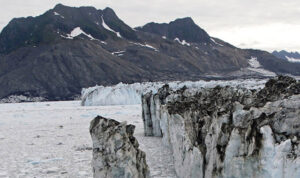Understanding the Ocean of the Past Using Ocean Sediments

During the last glacial period much of the Northern Hemisphere was blanketed by one or more sheets of ice. Throughout this period, chunks of these continental ice sheets often broke off and surged into the North Atlantic, carrying with them large amounts debris and freshwater. These events, called Heinrich events, are often thought to have been responsible for changes in ocean circulation patterns; specifically, weakening the Atlantic Meridional Overturning Circulation (AMOC), a system of currents that transports water and heat from the Southern to the Northern Hemisphere in the Atlantic basin.
Evidence for past ocean circulation patterns, and changes in them, comes from a variety of sources, including model experiments and measurements of carbon and oxygen isotopes in the shells of benthic foraminifera. By looking at the relative abundance of oxygen isotopes in the shell of a foraminifer, scientists can get clues to the temperature and the salinity (and, therefore, the density) of the water in which it was formed. Since the AMOC is driven in part by density gradients, understanding past seawater density is necessary in order to correctly reconstruct the current’s flow and strength.
In a recent study published in Nature Geoscience, entitled “Muted change in Atlantic overturning circulation over some glacial-aged Heinrich events,” a team of researchers investigated the impact of Heinrich events on the AMOC by studying benthic foraminfera from cores on either side of the Florida Straits. The Florida Current, which passes through the Florida Straits, is particularly sensitive to changes in the AMOC, making it an ideal study location.
The team, lead by Jean Lynch-Stieglitz (Georgia Institute of Technology), and including BIOS Director Bill Curry, combined isotopic oxygen measurements with existing reconstructions and model experiments to study the three most recent Heinrich events. They found evidence that, during some Heinrich events, reductions in the strength of the AMOC were of a much smaller magnitude and/or of shorter duration, than others.
These results suggest that changes in low-latitude climate patterns (e.g., drier than normal conditions, warming of the ocean and climate, etc.) often associated with Heinrich events may not be the direct result of changes in the AMOC-driven heat transport, as is commonly thought. Instead, the researchers suggest that other factors, such as changes in land ice over North America or sea ice cover in the North Atlantic, might impact the atmospheric circulation and climate patterns.
